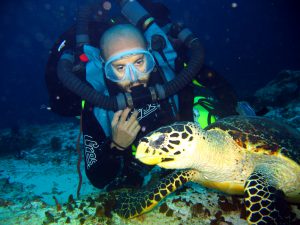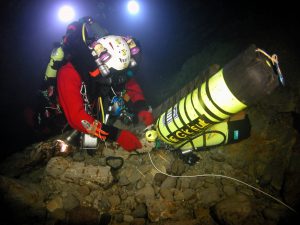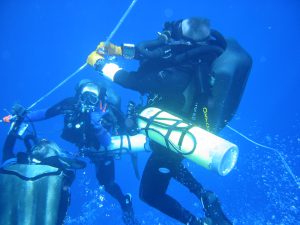Questions and Answers
Next is a collection of technical queries and explanations. These have crossed our phones, emails, and mailboxes over the years. Some of the more interesting follow, and some have been mentioned in earlier Tech Corner articles in Sources:
 Deepest dive first destroys bubbles on next dive?
Deepest dive first destroys bubbles on next dive?
Maybe. Bubble and seed reduction on successively lessening pressure cycles have been seen in the laboratory but never measured in divers per se. Seems sensible from both the bubble and dissolved gas sides, as successively shallower dives result in lower computed tissue tensions with table and meter usage.
Bubbles obey Boyle’s Law under compression-decompression?
Nada again. Bubble shells in the body are normally lipid or aqueous substances. Under pressure and/or temperature changes, these substances render the gas inside as non-ideal. Non-ideal gases do not obey Boyle’s Law though the departure is small for thin aqueous shells and more pronounced for thick lipid shells.
M-values and Z-values are limit points for bubble formation in divers?
No. In the early days, it was thought that M-values and Z-values were metastable dissolved gas limit points for spontaneous bubble formation (called de novo bubbles). M-values and Z-values are neither limit points for de novo bubble formation nor any other mechanism. They are dissolved gas (statistical) limits for possible DCS symptomology in divers for arbitrary tissue compartments. They were formulated using DCS outcomes or Doppler scores against computed (GM) dissolved gas tensions by the medical community. Most M-values and Z-values for nonstop and light decompression diving have a DCS incidence rate below 1 percent on the average. Lowering Mvalues lowers DCS incidence rates as reported by the medical community. Remember, most importantly, bubbles form on every dive.
Nucleation and cavitation are the same thing?
Not quite. The processes are distinctly different mechanisms. Unfortunately, terms are used interchangeably at times. Cavitation refers to the separation of liquid layers, holes, and defects and/or subsequent filling of voids with gas or vapor. Nucleation underscores the existence of preformed, very small, gas microemboli that possibly receive cavitation void gas or vapor and grow depending on conditions. The lifetimes of the gas microemboli are unknown in divers. Gas nuclei are also thought to possibly stabilize for longer periods of time seeding bubble growth after pressure changes independent of any cavitation. A debated issue in divers is the question of persistent micronuclei. And time scales for persistence.
 High blood flow speeds support Reynolds cavitation?
High blood flow speeds support Reynolds cavitation?
No. Incipient cavitation indices for owing blood, vorticular or laminar, are orders of magnitude too small, Cavitation occurs in flowing watery systems when cavitation indices fall below threshold (incipient) values. Incipient (spontaneous) cavitation indices for flowing water (blood) are close to 1.0 at room temperature and sea level. For maximal blood flow rates near 30 cm/second in the vena cava at sea level, the cavitation index is about 2000 while at 18,000 ft the index is 900 treating the flow as near laminar. With vorticular flow, in and around heart valves and bending constrictions, the indices are roughly 1400 and 600. In both the laminar and vorticular cases, cavitation indices are too high by orders of magnitude. Bubbles observed around prosthetic heart valves likely occur due to mechanical friction.
Helium bubbles are smaller but more numerous than nitrogen bubbles in divers?
Not really known in divers but seen in substrate experiments. Suggested by molecular properties of both gases. Computer bubble algorithms focusing on helium and nitrogen number distributions usually take the total bubble volume of both to be nearly the same in diver staging calculations. The cumulative volume of all bubbles in a bubble number distribution is called the phase volume and is used to limit diver ascents in BMs.
Helium NDLs are greater than nitrogen NDLs because nitrogen outgases slower?
No categorically until you reach the 200 fsw level. At that point, they are both very short. Otherwise, helium NDLs are shorter, just the opposite.
Does the product of gas diffusivity times solubility scale NDLs and decompression staging?
Yes actually, but you will not see this in available tables, software, or decompression meters popularly used these days. That may change.
 The high solubility of nitrogen generally makes nitrogen less desirable for diving?
The high solubility of nitrogen generally makes nitrogen less desirable for diving?
For sure, especially when coupled to its molecular weight. But air is plentiful and cheap, and helium is expensive. Technical and professional divers do not dive deep air these days with the limiting depth for air diving being something in the 130 fsw range. Nitrox and helitrox are even better shallow gas choices than air.
Staging with trimix, it is advantageous to increase oxygen fraction with the corresponding decrease in helium fraction on OC gas switches?
Yes, thereby keeping the nitrogen fraction relatively constant on ascent and decompression. Bottom mix should keep the nitrogen fraction as low as possible and the oxygen fraction constrained to avoid oxygen toxicity. The rest is helium.
The Pyle half-stop (ad hoc) protocols correlate with the VPM and RGBM?
No, not rigorously but like the Bennett and Marroni prescriptions, half-stop protocols mimic broad features of bubble models (BM).
The deep stop VPM and RGBM models can be tweaked to yield shallow stops?
Only using very strange bubbles or very large permissible bubble-dissolved gas gradients as occur with nonstop diving in the shallow zones. Deep stop and shallow stop models converge for nonstop diving in the recreational zones (less than 130 fsw).
 The RGBM is patterned on Doppler bubbles?
The RGBM is patterned on Doppler bubbles?
No. Doppler bubbles are moving bubbles in the bloodstream coming from sites all over the body. They correlate weakly with DCS incidence in divers excepting limb bends. The RGBM is correlated with DCS outcomes in actual profile data downloaded from dive computers.
RGBM nonstop times are shorter than Haldane nonstop times?
Mostly no, depending on the mix. RGBM single dive nonstop limits and Haldane nonstop time limits are roughly the same across recreational diving and even technical diving.
The RGBM and VPM are correlated with diving data?
Definitely yes, as stated over and over.
Click here to review Part One, Part Three and Part Four of the series. from the series.


